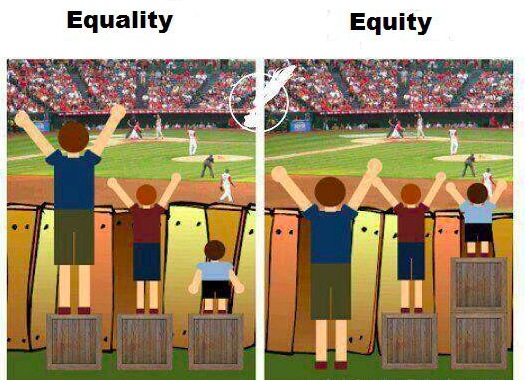 Equality and equity may once have been completely interchangeable terms but in law and as pertains to social justice matters, they are not the same any longer. Equity speaks to making allowances for handicaps created by historic, economic or racially based lack of access in order to level the playing field for everyone. Equality is the goal of equity considerations: by giving a leg up to the underserved, we hope to become a society where all are truly equal.
Equality and equity may once have been completely interchangeable terms but in law and as pertains to social justice matters, they are not the same any longer. Equity speaks to making allowances for handicaps created by historic, economic or racially based lack of access in order to level the playing field for everyone. Equality is the goal of equity considerations: by giving a leg up to the underserved, we hope to become a society where all are truly equal.
Oxford Dictionary defines equity as “A branch of law that developed alongside common law in order to remedy some of its defects in fairness and justice, formerly administered in special courts.”
 The Sex and Gender Based (SGBA) e-learning resource explains:
The Sex and Gender Based (SGBA) e-learning resource explains:
…we know that runners in the inside lanes have a distinct advantage over runners in the outer lanes because the distance they have to travel is shorter. As a result, equality – starting at the same place – doesn’t result in fairness.
The concept of equity …(leads) us to stagger the starting positions of the runners in order to offset the disadvantages facing those in the outer lanes.
The American Library Association (ALA) offers an entire page of detailed analysis about what equity and equality mean, and what sets them apart from each other linguistically and philosophically.
But, the best statement about equity is housed on the City of Portland, Oregon’s website:
The school of thought that says we should be “colorblind” and treat everybody equally, ignores the historic exclusion of those not considered white and the need to recognize and value our differences. In the context of race, being colorblind marginalizes negative racial conflicts, cultural heritage, and unique perspectives of people of color. Colorblindness stands in the way of our necessity to address racial differences and difficulties—we cannot be colorblind until we address all the issues that color consciousness has created.
Amen to that!
BTW, I found this statement about a Canadian government agency’s Employment Equity hiring policy thoughtful, and quite instructional.

